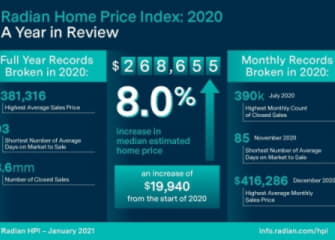
2020 will go down in the history books for many reasons, but one bright spot in a year of darkness is the performance of the U.S. residential real estate markets. December 2020, like much of the year, recorded very strong home price appreciation. According to Radian Home Price Index (HPI) data released today by Red Bell Real Estate, LLC, a Radian Group Inc. company (NYSE: RDN), home prices nationally rose from the end of November 2020 to the end of December 2020 at an annualized rate of 8.5 percent. The Radian HPI is the most comprehensive and timely measure of U.S. housing market prices and conditions.
For the full year, the Radian HPI rose 8.0 percent year-over-year (December 2019 to December 2020). Not unexpectedly, the year was a tale of two halves. For the first six months of the year, home prices nationally appreciated at an annualized rate of just 6.5 percent. However, the last two quarters recorded an annualized increase of 9.3 percent. The Radian HPI is calculated based on the estimated values of more than 70 million unique addresses each month, covering all single-family property types and geographies.
For the calendar year, national real estate records were broken in several important statistical categories.
National records broken in 2020:
- Highest Average Sales Price $381,316
- Shortest Days on Market to Sale 93
- Number of Closed Sales 3.6mm
- Average Active Monthly Listings 1.2mm
“In the end, there was nothing typical about 2020,” noted Steve Gaenzler, SVP of Data and Analytics. “As the country shut down in March, no one predicted what would happen over the remainder of the year. Despite a global pandemic, social unrest at levels not seen in generations, and a divisive political environment, the U.S. housing market thrived. In many ways, this was a Black Swan outcome, albeit a positive one.”
“The confluence of fiscal policy, monetary policy, the administration, and private sector innovation such as remote valuations, digital closings and many other product innovations, paved the way to not just stabilize housing, but to create an environment for strong growth,” added Gaenzler.
NATIONAL DATA AND TRENDS
- Median home price in the U.S. rose to $268,655
- Home prices rose an annualized 9.3 percent over the final quarter
The national median estimated price for single-family and condominium homes rose to $268,655, representing a more than $19,940 increase in the calendar year. 2020 recorded both historic low average monthly listing counts (supply) as well as record high sales volume (demand), as homes moved very efficiently through the real estate process. A review of the year by home price reveals some interesting trends: higher priced homes (those listed above $250,000) did not encounter record low average monthly supply, but did achieve record sales volumes. However, while lower priced homes (those listed at or below $250,000) suffered from record low listings (supply), sales volumes did not tally any records. This suggests that higher priced homes were in higher demand than starter or lower priced homes, something not surprising given the disparate impact the national pandemic had on certain lower income families.
Across the U.S., home prices nationally rose 9.4 percent in the final quarter, the strongest quarter of the year, and a strong increase over the first, second and third quarter appreciation rates of 6.3, 6.6 and 8.9 percent respectively. The imbalances between housing supply and demand continued to provide solid support for home prices throughout the year. On the demand side, December 2020 recorded the highest level of monthly home sale transactions as compared to any previous December and was the second strongest month of any fourth quarter. Strong demand for limited supply continues to keep the average number of days that a property for sale is listed before going under contract in December at the shortest levels in over a decade, and near the record low for days on the market.
REGIONAL DATA AND TRENDS
- States set records in all transactional categories tracked
- From year earlier, Midwest maintains strongest Region
Regionally, five of our six regions had stronger home price appreciation in 2020 than they did in 2019. The MidAtlantic region, which includes New York, Philadelphia and the Washington-Baltimore region (all areas severely impacted by COVID-19 and associated economic pains), was the only region to record lower annual appreciation. However, at +6.5 percent, the region still did quite well. The strongest performing region of 2019, the Midwest, held on to the title through 2020. Notably, the West and Northeast, two of the weakest performing regions of 2019, were the second and third best in 2020. Other than the MidAtlantic, regional performance was similar with all regions ending the year with appreciation rates between 7.5 and 9.1 percent.
The breadth of market strength in real estate was stunning this past year. Similar to our national reporting, states broke records in nearly all transactional categories.
State Records in 2020:
- Highest Number of Closed Sales 37 states
- Highest Average Sales Price 47 states
- Highest Average Listing Price 46 states
- Shortest Days on Market to Sale 31 states
Pace of home price appreciation differs by state; however all 50 states recorded positive home price appreciation in 2020. In fact, 44 states recorded faster appreciation in 2020 compared to 2019. In 2020, in the ten most populous states, all of them captured home price growth faster in 2020 than 2019 and the average increase was above the national average.
METROPOLITAN AREA DATA AND TRENDS
- Largest metropolitan areas grew in 2020
- 2020 is on pace to be one of the most active on record
Across the 20-largest metro areas of the U.S, the second half of the year dramatically outperformed the first half. Five metro areas, Chicago, IL, Boston, MA, Philadelphia, PA, Miami, FL and Riverside, CA recorded price appreciation rates in the second half of the year that were more than double that of the first half. For the year, all but one metro (Baltimore, MD) logged higher 2020 appreciation rates than 2019. The average median estimated home price of homes in the 20-largest metros is higher by more than $24,450 over the last 12 months.
Throughout 2020 much dialogue was spent on trying to determine whether homeowners were moving out of larger cities to improve their standard or quality of living. The Radian HPI data indicates that smaller cities outperformed mega-cities in 2020. Of a group of 50 cities that represent large and small communities, and include the most important regional and mega-cities, the average city HPI rose more than 7.5 percent in 2020. The top half of these cities grew an average rate of 10.5 percent and included only three of the top 25 largest (mega) cities in the U.S. (Austin, TX, Seattle, WA, Phoenix, AZ). The bottom half of this list, however, included 12 of the 25 most populous mega-cities such as Los Angeles, CA, Houston, TX, and Boston, MA, and grew at only 6.5 percent.
ABOUT THE RADIAN HPI
Red Bell Real Estate, LLC, a subsidiary of Radian Group Inc., provides national and regional indices for download at info.radian.com/hpi, along with information on how to access the full library of indices.
Additional content on the housing market can also be found on the Radian Insights page located at https://radian.com/news-and-knowledge/insights.
Red Bell offers the Radian HPI data set along with a client access portal for content visualization and data extraction. The engine behind the Radian HPI has created more than 100,000 unique data series, which are updated on a monthly basis.
The Radian HPI Portal is a self-service data and visualization platform that contains a library of thousands of high-value indices based on both geographic dimensions as well as by market, or property attributes. The platform provides monthly updated access to nine different geographic dimensions, from the national level down to zip codes. In addition, the Radian HPI provides unique insights into market changes, conditions and strength across multiple property attributes, including bedroom count and livable square footage. To help enhance customers’ understanding of granular real estate markets, the library is expanded regularly to include more insightful indices.
In addition to the services offered by its Red Bell subsidiary, Radian is ensuring the American dream of homeownership responsibly and sustainably through products and services that include industry-leading mortgage insurance and a comprehensive suite of mortgage, risk, title, valuation, asset management and other real estate services. The company is powered by technology, informed by data and driven to deliver new and better ways to transact and manage risk. Visit www.radian.com to see how Radian is shaping the future of mortgage and real estate services.









